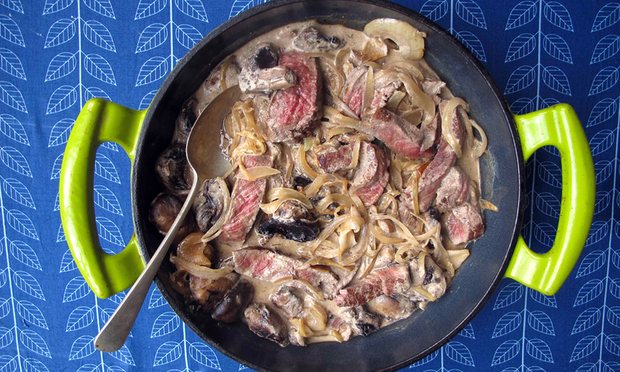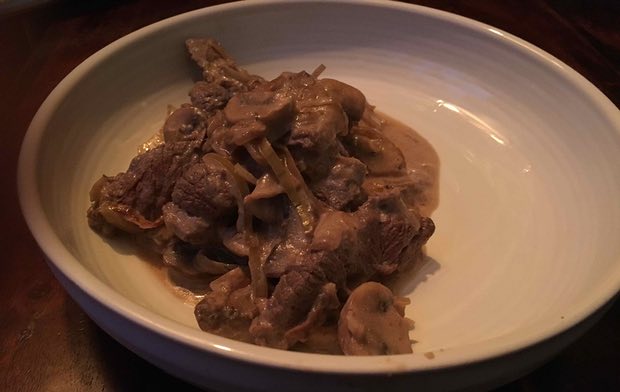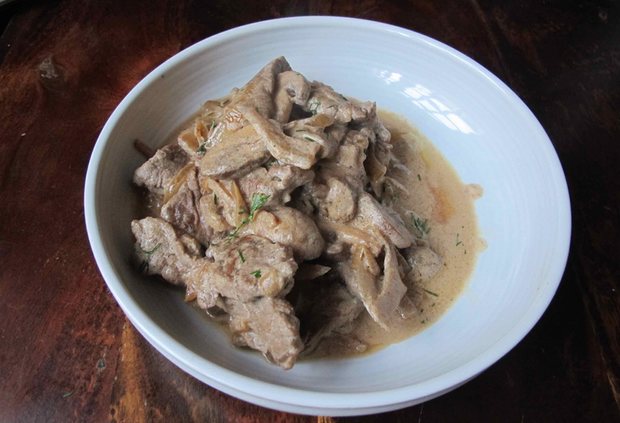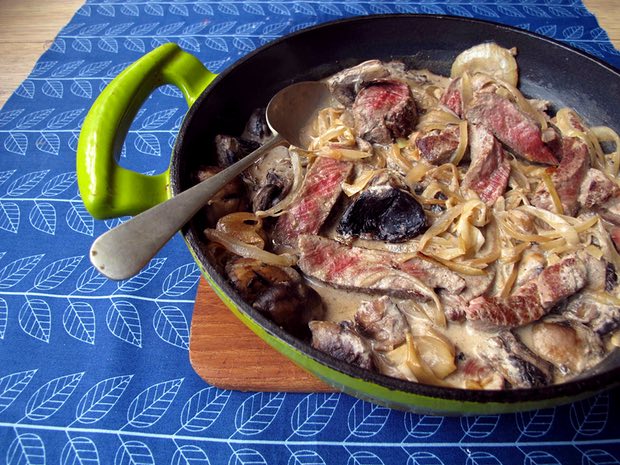How to cook the perfect beef stroganoff
This 70s favourite is overdue a revival. But do you stay authentically Russian with a flour-and-butter roux or add the sharper notes of sour cream and mustard?

Russia hour: Felicity Cloake's perfect beef stroganoff, cooks in minutes. Photograph: Felicity Cloake for the Guardian
Named after, if perhaps not created for the 19th-century Russian celebrity count, stroganoff rolls off the tongue as richly as the dish itself. First mentioned in print in 1871, the notion of sautéed beef in a piquant, creamy sauce is much older – but the aristocratic Stroganov seems an appropriate patron saint for what is, after all, a very decadent recipe. It has popped up in British cookery books since the early 1930s, but stroganoff's heyday, both here and across the pond was the postwar period, when its continental provenance made it the staple of the fashionable dinner-party circuit. And then, as with its comrades chicken kiev, and rum baba, it suddenly fell from grace, relegated to dismal buffets and, shame upon shame, occasionally as a topping for jacket potatoes. How the mighty have fallen.
Put aside the chafing hotplates and step away from the spuds, because stroganoff is a true special occasion dish. And, although it looks like a rather fancy stew, it is actually surprisingly quick to cook. Rich enough to keep you warm, retro enough to make you smile, the revival starts here.

Elena Molokhovets's stroganoff. Photograph: Felicity Cloake for the Guardian
Beef
Traditionally, recipes call for the tail end of fillet, which – though it is indeed the cheaper part of this ruinously expensive cut – still doesn't work out cheaply. You will also need a friendly butcher, because it is not something you generally find in supermarkets. In my opinion, the problem with all fillet is not price alone; devoid of either texture or flavour, it is just so boring to eat. I decide to experiment with different cuts and find that although something sold as a "medallion steak" (from where unspecified) proves chewy and fibrous, sirloin – though not quite as melt-in-the-mouth as fillet – is acceptably juicy and tender if you are careful not to leave it on too long; according to my testers, it tastes more interesting, too.
Elena Molokhovets, who includes the first recipe for "stroganoff" in the 1871 edition of her book, A Gift to Young Housewives, cubes the steak; Jane Grigson cuts it into strips in her Sainsbury's collection, Dishes from the Mediterranean (reprinted in the recent Best of Jane Grigson); and, in The Prawn Cocktail Years, Lindsey Bareham and Simon Hopkinson suggest thick slivers. I am with them: cut the beef too thinly and it is easy to overcook it, so err on the side of generosity.

Jane Grigson's stroganoff. Photograph: The Guardian
That said, it is difficult for the home cook to achieve any kind of significant browning on slices of meat, and, though no doubt this would not have worried the dish's creators, to my mind, browning equals flavour. As J Kenji López-Alt writes in Serious Eats: "With so much surface area, strips of steak end up exuding a lot of moisture into the pan as they cook. This moisture drastically reduces the efficiency of cooking (It takes about 500 times as much energy to get one gram of water to evaporate as it does to raise the temperature of that water by one degree F!). Unless you've got a jet engine installed in your kitchen, it's nearly impossible to get a good, deep brown sear on a thin strip of beef without completely overcooking it." In order to rectify this sad situation, like him, I am going to sear the meat before slicing.
A note in Max Clark and Susan Spaull's Leiths Meat Bible intrigues me. It says: "If using tougher meat than fillet … the beef must be stewed gently … this alternative method can produce very good results." Boldly. I have a go with braising steak, simmering it gently in stock for over an hour, only to end up disappointed (probably because said steak is irredeemably old bootish). I suspect, with a little more effort, it is certainly possible to make a delicious slow-cooked stroganoff, but it does not seem quite in the spirit of the original.

Max Clark and Susan Spaull's Leiths stroganoff. Photograph: The Guardian
Molokhovets marinates the beef in salt and allspice for a couple of hours before cooking, which helps with its somewhat muted flavour, although personally I prefer the nutmeg that Nigella Lawson suggests adding to the dish. Full disclosure: I'm a complete nutmeg fanatic; if you are less keen, you can use allspice, or indeed black pepper.
The vegetables
Molokhovets keeps things very simple by making her stroganoff with beef alone, but most modern recipes include onions and often mushrooms, too. Not only do these two flavours work well here – the onions adding sweetness as a counterpoint to the tangy sauce and the mushrooms giving it a savoury depth – but they help to bulk it out so that the beef goes further. It is important to cook the onions right down, as George and Helen Papashvily recommend in the much-loved Time-Life: Russian Cooking, though, like Bareham and Hopkinson, I would sauté the mushrooms separately so they don't go, well, mushy.

George and Helen Papashvily's stroganoff. Photograph: The Guardian
Recipes tend to recommend white button mushrooms for this dish. I try it with chestnut as well, as I tend to think they have a slightly better flavour. But, like the steak, so long as they are cooked in a hot-enough pan, you can use whatever you have to hand.
The sauce
The biggest area of contention with stroganoff is the nature of the sauce. Molokhovets's version starts with a flour-and-butter roux, loosened with beef stock and just a little dairy, while Grigson uses nothing but sour cream. My testers found the latter approach a little bland and heavy for their tastes (though as Bareham and Hopkinson observe: "The most important part of the dish is its relentless richness and bland, creamy texture"). Yet it is hard to argue with the fact that cream is fundamentally more satisfying to eat than a flour-thickened sauce. To this end, I will be cutting mine with beef stock, as the Leiths Bible also suggests, to give it a bit more oomph, and a little less fat. Simmering it down slightly, as in The Prawn Cocktail Years recipe, also helps with the flavour.

Lindsey Bareham and Simon Hopkinson's stroganoff. Photograph: The Guardian
You could use creme fraiche instead, as per Leiths, but note that it is more calorific than sour cream, and does not seem to bring anything extra to the party.
The flavourings
The first ingredient that sprung to mind when beef stroganoff was mentioned (OK, the third thing, after beef and sour cream) was brandy; it just seemed like one of those classic dinner-party dishes that demands a generous slug of booze. In fact, only the Leiths recipe flames the pan with brandy and, fun as that procedure is, it does not seem to add much to the finished dish.
Instead mustard, often omitted from 20th-century stroganoffs, feels like the rightful occupier of that third-most-important ingredient plinth; it is the principal flavouring in Molokhovets's version, also used by Grigson and the Papashvilys. A good slug not only gives the dish some much-needed heat, but helps to cut through the richness of the sauce. Molokhovets recommends sareptskaja mustard, which is available from Polish grocers, but fiery English mustard works just as well. Bareham and Hopkinson use paprika to add spice instead, but mustard seems truer to the original recipe, or at least earlier versions of it.
Grigson and Papashvilys add sugar to their sauces, but the natural sweetness of the onions should be enough. The same goes for Bareham and Hopkinson's lemon juice against the tanginess of sour cream, though clearly if you think it needs a little more sharpness, feel free to squeeze a little in. The Prawn Cocktail Years duo also stir in some chopped dill towards the end of cooking, which is always a temptation for me when it comes to foods from Russia and eastern Europe, though my testers came down firmly against it here, complaining that, when combined with the mustard, it reminded them of the sauce served with salmon. That is definitely not the idea.
This particular dish is traditionally served with crunchy straw potatoes (in its homeland), or rice (here), but is also pretty good with noodles or even mash. Chilled vodka optional.
The perfect beef stroganoff

The perfect beef stroganoff. Photograph: Felicity Cloake for the Guardian
-
Serves 4
- 600g sirloin or fillet steak
- Salt
- Nutmeg or ground allspice (optional)
- 50g butter
- 2 large onions, thinly sliced
- 2 tbsp oil
- 300g white or chestnut mushrooms, left whole if small, or cut in halves or quarters
- 250ml sour cream
- 1 tbsp sarepska or English mustard
- 150ml beef stock
Sprinkle the steak with salt and nutmeg or allspice if using (you can substitute black pepper if you prefer) and leave for at least an hour at room temperature.
Half an hour before you want to serve, melt half the butter in a wide pan and cook the onions gently until soft and golden and sweet.
Meanwhile, heat the oil in a frying pan until smoking hot, fry the steak for about 1½ minutes on each side until well browed, then set aside.
Scoop the onions from the pan and set aside. Add the remaining butter to the pan and turn the heat up. Sauté the mushrooms until softened then set aside with the onions.
Put the cream and mustard in the mushroom pan and heat gently until it liquifies. Very gradually whisk the stock into the cream. Add the onions and mushrooms back to the pan. Thickly slice the steak and add back to the pan to simmer gently for 10 minutes. Season to taste.
Beef stroganoff: a welcome blast from the past or a heavy, bland reminder of the bad old days of European cookery? Has anyone got a soft spot for the US versions with tinned soup, or tomatoes? And what do you like to serve it with?